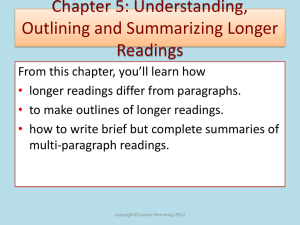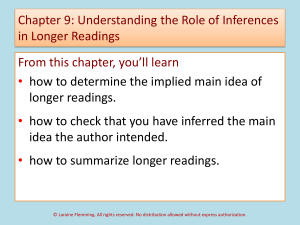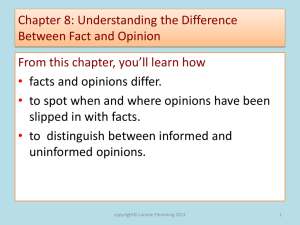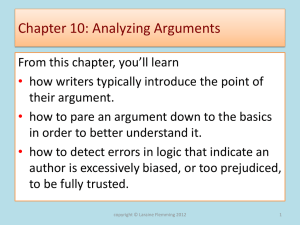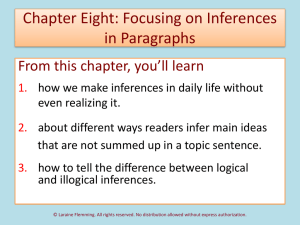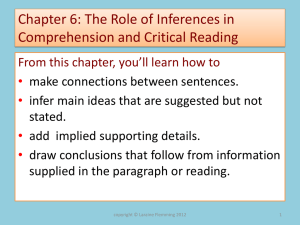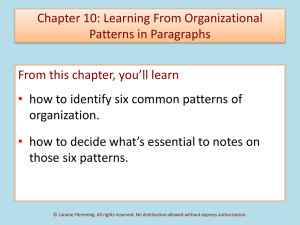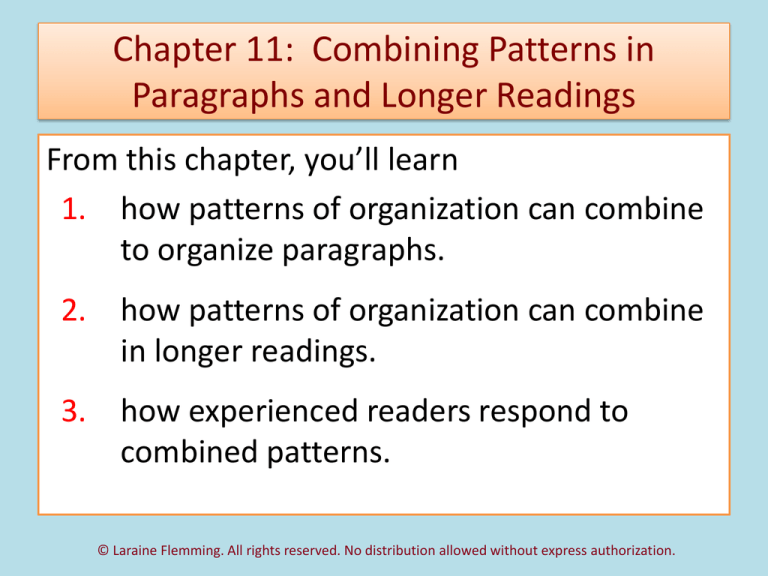
Chapter 11: Combining Patterns in
Paragraphs and Longer Readings
From this chapter, you’ll learn
1. how patterns of organization can combine
to organize paragraphs.
2. how patterns of organization can combine
in longer readings.
3. how experienced readers respond to
combined patterns.
© Laraine Flemming. All rights reserved. No distribution allowed without express authorization.
Patterns Combining in Paragraphs
• It’s the main idea that dictates the organizational pattern,
not the other way around.
• Which patterns do you think would be needed to organize
paragraphs explaining these three main ideas:
1.
2.
3.
Like the blues in the twenties and thirties, hip-hop
voices anger and discontent.
Storms are disturbances of the atmosphere, which
range from desert dust storms to tropical typhoons.
Deserts are much more various than most people
realize, and temperatures in the desert can range from
mild to cold.
© Laraine Flemming. All rights reserved. No distribution allowed without express authorization.
Identifying Multiple Patterns
How many organizational patterns do you see in this paragraph? What clues to
those patterns led you to your conclusion?
• According to economists, there are four different types of unemployment, each
with its own specific cause. The first type of unemployment is seasonal.
Workers in certain industries—such as agriculture, resorts and retail—are
subject to fluctuating demands for their services because of peak and off-peak
times in these industries. This type of unemployment is regular, predictable,
and relatively short-term. The second type of unemployment is referred to as
frictional. It is caused by school and college graduates seeking jobs for the first
time and by workers changing jobs. These people usually remain unemployed
for just a short time while they seek a position. A third type of unemployment
is structural, caused, for example, by the use of new machinery, such as robots,
that can perform simple repetitive tasks. Workers displaced by structural
changes often experience long-term unemployment while seeking a job that
matches their skills and salary expectations. The last type of unemployment is
cyclical. This kind is produced by the overall business cycle. Cyclical
unemployment increases in recessions;* it decreases during growth periods.
*recessions: periods of economic downturn
© Laraine Flemming. All rights reserved. No distribution allowed without express authorization.
© Ulrich Flemming
A Few Words to the Wise
Once you identify the pattern or patterns a writer uses,
1. you are in a better position to determine what’s critical to
store in long-term memory and what is not.
2. you have a structure that your memory can use to link
pieces of information together, e.g., the writer identifies
three causes of one effect.
© Laraine Flemming. All rights reserved. No distribution allowed without express authorization.
Combining Patterns in Longer Readings
Like main ideas in paragraphs, main ideas in
longer readings often require more than one
pattern of organization to be fully developed.
Look, for instance, at the following reading,
paragraph by paragraph. What patterns
emerge as the author describes the role of
identity-protecting software and the invisible
or deep Web?
© Laraine Flemming. All rights reserved. No distribution allowed without express authorization.
Being Anonymous in the Deep Web
In 1995, Ian Clarke was a young, Irish grad student finishing up his thesis on how
to mask the identity of Internet users who wanted to remain anonymous. At the
time, Clarke’s instructors weren’t especially impressed with his work. However by
2000, even they probably had second thoughts. By then, Clarke had released
software, called Freenet, which, at no cost, enabled users to browse the web
without detection. Around the same time, a growing number of people were
using that part of the Internet variously called the “dark,” “deep,” or “invisible”
Web. The term referred to the huge portions of the Web not accessible by search
engines like Google. Believed to be 500 times bigger than the known or “surface,”
the deep Web had become the meeting ground of various Internet users, ranging
from serious scholars, investigative journalists, political dissidents, and
international criminals. For those users who wanted to conduct their Web
activity in secrecy, Clarke’s software was a godsend, and he himself a pioneer in
the protection of Web privacy.
© Laraine Flemming. All rights reserved. No distribution allowed without express authorization.
Responding to Combined Patterns in Longer
Readings
What definition or definitions from the previous
paragraph need to be remembered in order for
you to say that you have understood the author’s
message?
© Laraine Flemming. All rights reserved. No distribution allowed without express authorization.
Do any of the previous patterns continue to be developed in
this second paragraph?
And Clark was not alone. Around the same time the
Scottish doctoral candidate was thinking about how
to make Web use anonymous, the U.S. Navy was
working on The Onion Router (the onion image was a
reference to the layers of encryption, or secrecy,
being created), another piece of software designed to
protect online anonymity. Nicknamed Tor, the
software eventually became available through the
sponsorship of the Electronic Frontier Foundation
and entered into widespread use.
© Laraine Flemming. All rights reserved. No distribution allowed without express authorization.
What pattern or patterns organize the information in
this paragraph?
For Web users living in countries that repressed free
speech, identity protection software like Freenet or Tor
was a godsend. Chinese bloggers searching for and
publishing articles critical of the government were clearly
not interested in making their identity known to officials
intent on throwing dissident bloggers in jail. For these
persons, online anonymity could mean the difference
between freedom and imprisonment. Similarly, journalists
wishing to protect their sources regularly made use of Tor
and Freenet as did corporations with employees working
in foreign countries that viewed outsiders with suspicion.
© Laraine Flemming. All rights reserved. No distribution allowed without express authorization.
What pattern or patterns do you recognize here?
Unfortunately, political dissidents, journalists, and
corporations were not the only ones who benefitted from
the use of identity-protecting software. Criminals had also
discovered that remaining anonymous on the Internet
worked in their interest. The deep Web is also home to
child pornographers, fight club promoters, assassins for
hire, drug dealers and a host of other bad seeds who
want to carry out their schemes as anonymously as
possible. These people are also aided in their efforts by
the use of software like Freenet and Tor.
© Laraine Flemming. All rights reserved. No distribution allowed without express authorization.
What pattern or patterns do you recognize in this paragraph?
Aware that identity protection software can sometimes be used by
despicable and dangerous criminals, Ian Clarke argues that the freedom
of expression identity-protecting software provides must be
safeguarded. He believe this even if, at times, the ability to cloak one’s
identity on the Web results in behavior he personally despises. Clarke is
supported by legions of Internet activists who insist that exploring the
Web anonymously is an absolute necessity, particularly when those
doing the exploring live under a dictatorship or are journalists trying to
protect their sources. As one might expect, police and government
officials around the world do not have quite the same attitude toward
identity protection software. They claim the ability to be anonymous on
the Internet aids and abets criminal behavior. They also say that they
are coming closer and closer to being able to trace any wrong-doing
hidden in the murky mist of the deep Web. And they might be right.
© Laraine Flemming. All rights reserved. No distribution allowed without express authorization.
Is there a noticeable pattern organizing the information here?
The 2013 revelations of former national security analyst Edward Snowden revealed
that the United States, aided by Britain, has a massive electronic surveillance data
mining program called PRISM, which was organized as a result of the Patriot Act.
According to the documents that Snowden published, using any kind of privacy
tools to hide your identity raises a red flag for the government. As Cato* fellow
Julian Sanchez summed up, “any encrypted U.S. person communications, once
acquired, can be retained indefinitely pending decrypt.” While such measures are
designed to track the plans of terrorists, it turns out that hiding your identity on
the deep Web—or for that matter the surface Web—makes the government
assume that you are not an ordinary U.S. citizen but very likely a foreign terrorist
meaning harm, “A person…whose location is unknown will not be treated as a
United States person, unless such person can be positively identified as such.”
What that suggests is that identity protection software, at least for those living in
the United States, is an incentive for surveillance and may well end up providing
less privacy rather than more.
*The Cato Institute: a think tank devoted to encouraging individual freedom and limiting
government interference.
© Laraine Flemming. All rights reserved. No distribution allowed without express authorization.
© Ulrich Flemming
A Few Words for the Wise
• Don’t assume that every important thought in a multiparagraph reading will be covered by an organizational
pattern.
• It’s possible for a writer to use one or more organizational
patterns and still communicate important information that
is not part of the pattern or patterns used develop the main
idea.
• The test for what’s important is always based on the main
idea using questions like “What information do I need in
order to fully explain or prove the main idea?”
© Laraine Flemming. All rights reserved. No distribution allowed without express authorization.
Responding to Combined Patterns in Longer
Readings
Recognizing several patterns in a reading doesn’t mean that you
need to record every element of that pattern. Instead, record
only those elements central to the main idea. For instance,
what was the main idea of the previous reading, and are both of
these dates and events equally central to an understanding of
the main idea?
1. 1995 – the year Ian Clarke was finishing up his dissertation.
2. 2000 – the year Clarke published software that could
disguise a person’s identity on the Internet.
© Laraine Flemming. All rights reserved. No distribution allowed without express authorization.
Responding to Combined Patterns in Longer
Readings
Which of these cause and effect relationships do you see at
work in the reading about the deep Web?
1. Freenet allowed people to navigate the deep Web in
secrecy.
2. The appearance of Kosmix has made Freenet software
obsolete.
3. Freenet has helped criminals to navigate the deep Web
without getting caught.
4. Freenet increased the possibility of free expression in
countries that repressed free speech.
5. Creating Freenet earned Ian Clarke a fortune.
© Laraine Flemming. All rights reserved. No distribution allowed without express authorization.
© Ulrich Flemming
Finishing Up: Combining Patterns of
Organization in Paragraphs and Longer Readings
You’ve previewed the major
concepts and skills introduced
in Chapter 11. Now take this
quick quiz to test your mastery
of those skills and concepts,
and you are ready to read the
chapter.
© Laraine Flemming. All rights reserved. No distribution allowed without express authorization.
Finishing Up: Combining Patterns of
Organization in Paragraphs and Longer Readings
1. What dictates the pattern or patterns of
organization in a paragraph?
2. What dictates the pattern or patterns of
organization in a multi-paragraph reading?
3. True or False. If a reading contains three
different patterns of organization, the
elements of each pattern are all equally
essential.
© Laraine Flemming. All rights reserved. No distribution allowed without express authorization.
Finishing Up: Combining Patterns of
Organization in Paragraphs and Longer Readings
4. What pattern or patterns are suggested by
the following topic sentence:
“Supreme Court Justice Antonin Scalia has
said that his outlook on life was profoundly
shaped by his years at Xavier Academy, a
Jesuit* Academy in New York.”
*Jesuit: a member of a Catholic religious order known for excellence in scholarship
© Laraine Flemming. All rights reserved. No distribution allowed without express authorization.
Finishing Up: Combining Patterns of
Organization in Paragraphs and Longer Readings
5. What pattern or patterns are suggested by
the following thesis statement:
“Years from now economists and historians
will probably still be trying to explain how
the financial crisis that did so much harm to
the United States left China not only
unharmed but in a better position than
before the downturn.”
© Laraine Flemming. All rights reserved. No distribution allowed without express authorization.
© Ulrich Flemming
Brain Teaser Challenge
© Laraine Flemming. All rights reserved. No distribution allowed without express authorization.
The Argentinean writer Manual Puig has said that
“As a rule, one should never place form over
content.” Does what Puig says fit what you have
learned from this chapter overview or do you
detect a difference of opinion? Please explain your
answer.
© Laraine Flemming. All rights reserved. No distribution allowed without express authorization.

